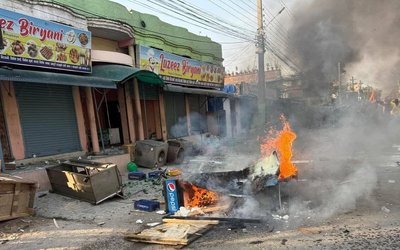More on News






A comprehensive report on the status of out of school children in Nepal was launched today by the Ministry of Education and UNICEF Nepal. Honorable Minister of Education Mr. Dhani Ram Poudel and UNICEF Representative to Nepal Mr. Tomoo Hozumi addressed the participants at the event. The report titled “All Children in School” offers a comprehensive overview of out-of-school children as well as children in school but who are at risk of dropping out.
Various data have shown that almost one million Nepali children still remain out of school the Report. By using all available authentic administrative data and findings of household surveys conducted between 2011 to 2014 in Nepal, it became possible to disaggregate this number and thus reveal various dimensions of inequality and barriers that cause non-enrollment and drop-out of children in terms of geographical location, income level, gender, language base and caste stratification.
School is out of reach for many children from the most disadvantaged families, despite the great strides Nepal has made in improving education system over the past decades.
"Through national legislation, policies and programs, the Government of Nepal has been working tirelessly to ensure quality education for all," said Hon. Minister of Education Mr. Dhani Ram Poudel, speaking at the launch ceremony. "Our net enrollment rate now has reached 96 per cent, and the recent Eighth Amendment of Education Act has made education free and compulsory up to Grade eight.
"I am confident that the report will prove extremely useful for policy makers, planners and implementers to understand who are the most vulnerable groups of children in terms of access to and retention in schools for basic education. This report will also be helpful to forge strong partnership among the concerned to reach out to the unreached children.
"The report has analyzed the issue of out-of-school children by considering Five Dimensions of Exclusion Model - a globally accepted methodology. The key findings of the report according to this five dimensional model include:
As per the Census 2011, 14.3.percent of 5-12 aged group children are out of school which is 0.77 million of the total population in this age group.
35.2 per cent of the out-of-school children reside in the districts of central Terai – mainly in Rautahat, Sarlahi, Mahottari, Dhanusha and Bara. The majority of the remaining 22 per cent are in Eastern Terai.
Children who are at risk of dropping out of school include those who start schooling late; new entrants in Grade one without pre-school experience; children who repeat grades; children underperforming in Grade eight; children involved in child labor, seasonal migration and marriage; children with disability and special educational needs; children speaking ethnic-minority language, and children residing in the earthquake-affected districts.
The key barriers to education for children of Nepal include poverty; social exclusion linked to caste/ethnicity; disability; migration; child labour; child marriage; trafficking; harmful social norms and gender biases; poor school infrastructure and staffing; language barriers; natural disasters and civil strife; governance and financing bottlenecks.
“I believe that the individual and household characteristics of out-of-school children presented in the report should make policies better informed and result in more intensive interventions for them from policy level to concrete actions to bring children into schools at the community level,” said Tomoo Hozumi, UNICEF Nepal Representative. “The insights, recommendations and the areas of further research presented in the report will also be instrumental in realizing an equitable and quality education system in Nepal - one that ensures full access, participation and good learning by all children, including those at the risk of dropping out.”
The report “All Children in School” is a part of the Global Initiative on Out-of-School Children launched by UNICEF and UNESCO Institute for Statistics (UIS) in 2010. The initiative seeks to identify the barriers that prevent children from participating in a full course of basic education; show gaps in data and research; provide evidence to make informed policy decisions to address educational deprivation; and establish a basis for innovation and follow-up actions to ensure quality education for all children.
.






